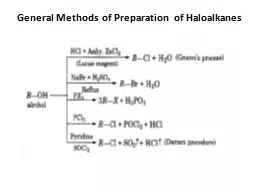

Haloalkanes Hunsdiecker Reaction Addition of Hydrogen Halides on Alkenes Markownikoffs rule Anti Markownikoffs rule Physical properties of alkyl halides 1 Boiling point orders R I gt R Br gt R CI gt R F ID: 935721
Download Presentation The PPT/PDF document "General Methods of Preparation of" is the property of its rightful owner. Permission is granted to download and print the materials on this web site for personal, non-commercial use only, and to display it on your personal computer provided you do not modify the materials and that you retain all copyright notices contained in the materials. By downloading content from our website, you accept the terms of this agreement.
Slide1
General Methods of Preparation of Haloalkanes
Slide2Hunsdiecker Reaction
Slide3Addition of Hydrogen Halides on Alkenes
Markownikoffs
rule:
Anti
Markownikoffs
rule
Slide4Physical properties of alkyl halides
1.
Boiling point orders
R – I > R – Br > R – CI > R – F
CH
3
– (CH
2
)
2
– CH
2
Br > (CH
3
)
2
CHCH
2
Br > (CH3)
3
CBr
CH
3
CH
2
CH
2
> CH
3
CH
2
X > CH
3
X
2.
Bond strength of
haloalkanes
Decreases as the size of the halogen atom increases. Thus, the order of bond strength is
CH
3
F > CR
3
Cl > CR
3
Br > CH
3
I
3. Dipole moment decreases as the
electronegativity
of the halogen decreases.
Slide5Physical Properties of Haloalkanes
4.
Haloalkanes
though polar but are insoluble in water as they do not form hydrogen bonding with water.
5. Density order is
RI > R Br > R
Cl
> RF (For the same alkyl group)
CH
3
I > C
2
H
5
I > C
3
H
7
I
Slide6Chemical Reactions of Haloalkanes
Nucleophilic
Substitution Reactions (SN reactions)
Mechanism of substitution reactions of alkyl halides
Slide7SN1
type
(
Unimolecular
nucleophilic substitution reactions
Proceed in two steps:
Slide8Rate, r = k [RX). It is a first order reaction.Reactivity order of alkyl halide towards S
N
1 mechanism
3° > 2° > 1°
Polar solvents, low concentration of
nucleophiles and weak nucleophiles
favour S
N
1 mechanism.
Slide9In SN1 reactions, partial racemisation occurs due to the possibility of frontal as well as backside attack on planar carbocation.
Slide10SN2 type (Bimolecular nucleophilic
substitution)
These reactions proceed in one step and is
a second order reaction with r = k[RX] [Nu].
During SN2 reaction, inversion of configuration occurs (Walden inversion) i.e., starting with dextrorotatory halide a
laevo
product is obtained and vice-versa, e.g.,
Slide11Reactivity of halides towards SN
2
mechanism is
1° > 2° > 3°
Slide12Rate of reaction in SN2 mechanism depends on the strength of the attacking nucleophile.
Strength of some common
nucleophiles
is
:
CN- > : I- > : OR- > : OH- > CH3COO: > H
2
O > F-
Non-polar solvents, strong
nucleophiles
and high concentration of
nucleophiles
favour SN
2
mechanism.
Relative rates of some alkyl halides in S
N
1
and S
N
2
reactions are in the
order
Slide13Slide14Elimination Reactions
Dehydrohalogenation
is a β – elimination reaction in which halogen is from α-carbon atom and the hydrogen from the α-carbon according to
Saytzeff
rule, e.g.,
Slide15Reduction
Slide16Nucleophilic Substitution Reaction
Aryl
halides are less reactive towards
nucleophilic
substitution reaction. Their low reactivity
is attributed
due to the following reasons:
1
. Due to resonance, C-X bond has partial double bond character.
2
. Stabilisation of the molecule by delocalisation of electrons.
3
. (Instability of phenyl
carbocation
.
However
, aryl halides having electron withdrawing groups (like – NO2, -SO3H, etc.) at
ortho
and
para
positions undergo
nucleophilic
substitution reaction easily.
Slide17REACTIONS
Slide18Electrophilic Substitution Reactions
Halogens
are deactivating but O, p-directing. Thus, chlorination, nitration,
sulphonation
and
Friedel Craft’s reaction give a mixture of o- and P-
chloro
substituted derivatives.
Slide19NITRATION
Slide20SULPHONATION
Slide21FRIEDAL CRAFT REACTION